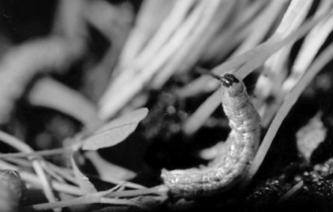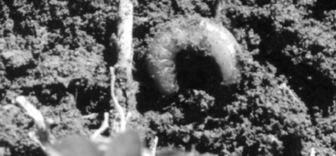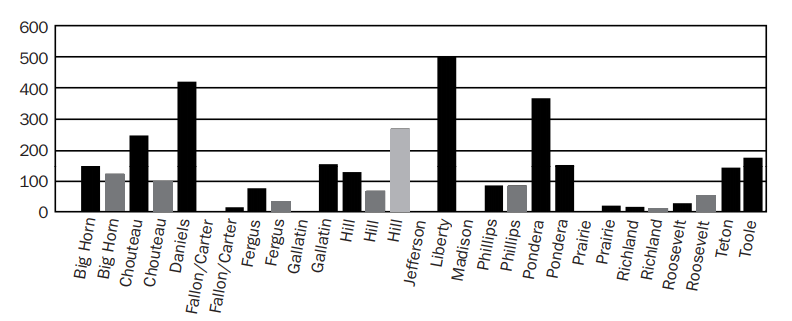
Pale Western and Army Cutworms in Montana
Describes the life cycle of the two cutworms, how to identify, monitoring adults and larvae, damage caused by them, and how to decide between control options: chemical, cultural management and biological control.
Last Updated: 04/17by Sue Blodgett, former MSU Extension IPM specialist; Greg Johnson, professor, Animal and Range Sciences; Will Lanier; and Judee Wargo, former MSU Extension agent, Chouteau County Reviewed by Kevin Wanner, Associate Professor, Plant Sciences and Plant Pathology
TWO MAJOR CUTWORM SPECIES, THE PALE
western and the army cutworm, are serious but sporadic pests for Montana producers. Outbreaks can occur when cutworm populations are high and weather conditions are favorable for survival. However, outbreaks do not necessarily occur in successive years. An area-wide adult survey has been used in Montana to assess moth activity of pale western and army cutworms which has helped in the forecast of damaging cutworm larvae populations.

FIGURE 1. A pale western cutworm (left) and an army cutworm are shown with a penny. (Photos in this publication are by P. M. Denke)
Origin and Distribution
Both cutworm species are native to North America. Army cutworms are distributed throughout the semiarid region of the G+reat Plains, extending to eastern Kansas with reports of occurrence as far east as Illinois and Michigan. They occur in Alberta as far north as the Peace River District and occasionally in Saskatchewan and Manitoba. Pale western cutworms occur from Alberta to Arizona and New Mexico, extending east to western North and South Dakota, Nebraska, Kansas and the panhandles of Oklahoma and Texas.
Army Cutworm
Life Cycle
The army cutworm begins laying eggs in late August and can continue through October. Up to 3,000 eggs are deposited per female on or just beneath the soil surface. Eggs hatch in the fall following rain or snow. This cutworm species overwinters in the larval stage. Larvae become active in late winter or early spring and are particularly damaging to winter wheat. Army cutworms feed above ground so evidence of feeding damage indicates their presence. However, they feed at night, from dusk to dawn, staying below ground during the day except on very overcast days when they can be found feeding above ground. This nocturnal behavior plus the small size of the early instar larvae (1.5 mm) makes them difficult to detect even though the feeding damage to foliage is obvious. When larvae are abundant and food supply is short, the larvae will move en masse to adjacent fields, hence the name army cutworm.
Mature larvae (40 to 50 mm) burrow into the soil and construct earthen cells in which they pupate. Adult moths, also known as millers, emerge from these cells in May and early June. An interesting phenomenon with this cutworm species is its seasonal migration to high elevations in the Rocky Mountains. Adult moths are active at night at these higher elevations, feeding on alpine flower nectar. During the day they form dense aggregations under stumps, logs and other structures that offer them protection from direct sunlight. Wildlife researchers report that these dense aggregations of cutworm moths are an important food source for grizzly bears in the absence of high-quality forage alternatives in July and August. Adult moths return to the plains in late summer and begin laying eggs. Dry periods during August tthrough October are detrimental to egg hatch and larval survival of army cutworms. Army cutworms have one generation per year.
Description
Adult army cutworm moths range from light brown to dark grayish-brown and are heavy-bodied. The forewing of the adult has a prominent circular spot and kidney- shaped marking. The hindwing is grayish-brown with a whitish fringe. Larvae are greenish-brown to greenish-gray with the dorsal (top) side darker than the ventral (under) side. A narrow, pale mid-dorsal stripe is usually present. The head is pale brown with brown to dark brown freckles.
Pale Western Cutworm
Life Cycle
The pale western cutworm has a life cycle similar to the army cutworm. Moths deposit up to 300 eggs per female in the upper two inches of loose soil in cultivated ground in early fall. Some hatching may occur in the fall but most eggs hatch the following spring. The newly hatched larvae are small, approximately ? inch, and difficult to detect. Larvae are subterranean and feed on plant stems below the surface of the ground. Mature larvae measure approximately 1½ inches and become less active, burrowing into the soil where they form an earthen cell.
FIGURE 2. An army cutowrm feeds on a canola seedling.

FIGURE 2. A pale western cutowrm is shown in the soil beside a plant base.

They pass most of the summer in the soil as a prepupa, with pupation occurring in August. Adult moths emerge from the cell during late summer, mate and lay eggs soon after. Pale western cutworm has one generation per year.
Dry weather favors pale western cutworm survival. Excessive precipitation in the spring can drown larvae in low-lying areas or force larvae to the surface of the soil where they are exposed to attack by predators and parasites. Wet weather produces conditions favorable for the increase of pathogens. A method of predicting cutworm outbreaks is based on the number of wet days (i.e., days on which more than a quarter inch of precipitation falls) in May and June. More than 10 wet days increase cutworm mortality; less than 10 wet days favor cutworm survival.
Description
The adult pale western cutworm is a gray to brownish white, heavy-bodied moth. Distinct markings on the wings are absent and the under-surface of the wing is white. Larvae frequently take on a characteristic C-shape when disturbed. The general body color of the larva is pale yellowish-gray with a distinct white mid-dorsal line. The head is yellow-brown with two distinct vertical black dashes that form an inverted V.
Adult Monitoring
Pheromone traps can be used to monitor adult flights of both cutworm moths. Pheromones are species-specific scents that are produced by females to attract males for the purpose of mating. For example, traps baited with army cutworm pheromone attract only male army cutworm moths. Traps are monitored weekly from early August through early October when moths are locating mates, mating and laying eggs. The cumulative moth catches for the duration of the trapping period indicate the relative abundance of each cutworm species in a locale and can be used to forecast the potential for damaging larvae populations the following spring. An advantage of using pheromone-baited traps is that captures are predominately single species and time spent sorting and identifying adult moths is minimized.
Separate traps with the appropriate lure (bait) are used for the army and pale western cutworms.
An example of adult pheromone trapping results are shown in Figure 4. Cumulative trap catches are shown for participating counties. When 200 pale western cutworm moths or 800 army cutworm moths or more have been trapped the potential for a damaging larval population the following spring by these species is great. However, these thresholds are highly influenced by climatic conditions that occur between moth flight and damage by larvae.

FIGURE 4. Adult pale western cutworm populations as trapped in several Montana counties. (Mulitple county listings indicate multiple trap sites in those counties.) Traps were monitored every week for eight weeks beginning in August. Potential for economic damage exist the following spring when pale western cutworm catches are greater than 200.
Larval Monitoring
Larvae of either species generally are not active above ground on bright, sunny days. They can be found just below ground by scraping the soil surface lightly. Small larvae are well-camouflaged and can be difficult to see in the soil. Larval densities can be assessed by digging and screening the soil from one foot of row or a square foot at different sites in the field. Soil samples should be dug to a depth of at least 3 inches. Soil can either be sieved through a fine mesh screen or placed on a piece of white paper; the white background can aid in detecting cutworm larvae. However, soil sieving is both labor and time intensive and has limited practicality as a routine sampling method.
Examining plants for signs of cutworm larval activity and for cumulative larval damage is a more practical approach to assessing larval populations. Damage by cutworms can be distinguished from winter kill by looking carefully for evidence of feeding damage.
Damage
Both pale western and army cutworms can feed on and damage wheat, barley, alfalfa, canola, peas and sugar beets. Bare spots in the field in early spring may indicate cutworm activity. The army cutworm is a climbing cutworm and feeds on above ground foliage. Damaged leaves indicate army cutworm damage. Plants may recover from army cutworm feeding if defoliation is not severe.
Pale western cutworm larvae are subterranean and feed on plants below the soil surface. Because pale western cutworms cut stems, if the growing point is destroyed, the plants cannot recover from damage. Pale western cutworm infestation results in stand reduction. Damage appears as dead or wilted tillers or plants.
As mentioned earlier, moisture can influence cutworm mortality. Records indicate that soil packing from compaction also forces larvae to soil surface.
Decision-making Guidelines
Early detection of damaging cutworm populations is critical. Adult monitoring provides valuable insight on the potential for damaging army and/or pale western cutworm populations in an area. Fields should be monitored periodically beginning in late winter or early spring for cutworm larvae. Treatment thresholds are directly related to the health and vigor of the growing crop. If the crop is experiencing moisture stress then the effects of cutworm damage will be more dramatic.
Small Grains: If plants are not drought-stressed and appear healthy and vigorous then insecticide treatment is justified when there are four to five army cutworm larvae per square foot. Treatment is justified for pale western cutworms when two to three larvae per foot of row are present. However, under drought conditions, treatment may be justified at lower cutworm larvae populations. Prior to making a decision to treat a field it is important to determine the size of the larvae. Large larvae indicate completion of the feeding or damaging stage of cutworms. When this happens the majority of the damage has been done and a treatment may not be cost effective.
Alfalfa: In mature stands, three to four cutworm larvae per square foot warrant making an insecticide treatment. In new seedling stands, two cutworm larvae per square foot cause economic damage.
Canola: The economic threshold is quite low because seedling canola plants have little ability to compensate for damage. Treatment can be justified at 0.3 to 0.5 cutworm per square foot.
Sugar beets: Army cutworms can seriously damage seedling sugar beets when they move from adjacent fields or grassy borders into emerging beet fields. Because sugar beets emerge and grow slowly during early establishment, cutworms can drastically reduce a sugar beet stand in a short period of time. Considerable problems with both pale western and army cutworms have resulted where winter cereal cover crops are grown during the winter and beets are direct seeded into cover crop. When the cover crop is killed the cutworms readily move to seedling sugar beets.
Very low cutworm densities, less than one cutworm per 20 feet of row, can cause significant damage. Large larvae can consume several plants each night, and if present in large enough numbers, can completely destroy a sugar beet stand in only a few nights.
Management
Chemical options for control
Several insecticides are registered for cutworm control in small grain, alfalfa, sugar beet and canola (Table 1). Other sources for registered insecticides include your local county Extension agent, the High Plains Integrated Pest Management Guide for Colorado, Western Nebraska, Montana and Wyoming (www.highplainsipm.org), or the Pacific Northwest Insect Management Handbook (www. uspest.org/pnw/insects).
Cultural management strategies
Tillage may cause some mortality of eggs (pale western) and small newly hatched larvae (army) already in soil. However, tillage is not compatible with no-till and conservation tillage production systems.
Biological Control
Both species of cutworms are attacked by wasp parasites belonging to the families of Ichneumonidae, Braconidae and Chalicidae and fly (dipteran) parasites. The following pathogens have been recorded from army cutworms: Beauveria sp., Isaria sp., Metarrhizium anisopliae (Metschnikoff), Sorosporella uvella (Krassilstischik) and an entomopox virus. Insectivorous birds are the most common vertebrate predators feeding on larvae.
References
Burton, R. L., K. J. Starks and D. C. Peters. 1980. The army cutworm. Oklahoma State University Agric. Expt. Stat. Bull. B-749. 35 pp.
Jacobson, L. A. 1971. The pale western cutworm, Agrotis orthogonia Morrison (Lepidoptera: Noctuidae): a review of research. Quaest. Entomol. 7: 414-436.

